Roo broth – I know, right? What is it, some kind of medieval kangaroo soup?
Well, no. Roo broth is more of a bruet – a kind of thickly sauced meat dish – a bit like a stew. The roo is not for kangaroos but roe deer, and this is the venison dish I cooked alongside the frumenty last week. Like last week’s recipe, it is from A Forme of Cury as translated in Pleyn Delit by Hieatt and Butler, and it goes like this:
Take the lire of the Deer oþer of the Roo parboile it on smale peces. seeþ it wel half in water and half in wyne. take brede and bray it wiþ the self broth and drawe blode þer to and lat it seeth to gedre with powdour fort of gynger oþer of canell. and macys. with a grete porcioun of vineger with Raysouns of Coraunte.
As far as I can make out, this means:
Take the liver and other meats of the roe deer. Cut it in small pieces and parboil it. Cook it well in a half water/half wine mixture. Take bread and soak it with broth and add a little blood to it. Let it all simmer together with ginger, cinnamon, and mace, and a large measure of vinegar with added currants.
Actually, if you’d like to see how the recipe looks in its true original format, the Rylands Medieval Collection has scanned the page here.
You’ll note here that the recipe mentions liver. I don’t have access to venison liver, so I just used stewing venison from Waitrose, which comes in at 300g for a fiver, so this proved to be an expensive experiment. Goodness, I hope it works!
Hieatt and Butler talk a little about the evolution of roo broth in their book, observing that later versions add onions and herbs but lose the currants and vinegar, which they retain. The sweetness of onions and currants is to counterbalance the vinegar used. Vinegar was frequently part of venison recipes in medieval times, and I don’t know but am guessing it is because it is an acid and game can be tough – it’s a way of pre-cooking meat. To this end, you might want to marinade the meat first, as Hieatt and Butler suggest.
Ingredients
You’ll need:
- 600g of stewing venison
- 300ml red wine
- 75ml red wine vinegar
- 60ml olive oil
- 2 chopped onions
- 3 or 4 branches of fresh thyme
- 1/2 tsp cinnamon
- 1 tsp salt (to taste)
- 1/2 tsp freshly ground black pepper
- Scant 1/4 tsp of ground mace (more of a dash of mace, really)
- 2 tbsp olive oil
- 2 slices granary bread
- 200ml of water (more if looking a bit thin)
- 100g raisins
- 2-3 tbsp of chopped parsley.
- (Optional) Get your full medieval on by serving it with frumenty, which is what venison was always traditionally accompanied with.
This looks like a lot of stuff, and the following looks like a lot of instructions, but really, it’s all very simple. Most of the chopping and adding happens in the marinade stage. Actually cooking it is a doddle.
The first step is to marinade the venison – this is a suggestion from Hieatt and Butler, and as I had never cooked venison before, this appealed to me as I had always heard the great danger in it would be that it would be tough. Then you’ll brown it. Then you’ll simmer it. And then, all going well, there will be something worth eating at the end.
Let’s kick off.
Marinading the venison
So, get your venison out:
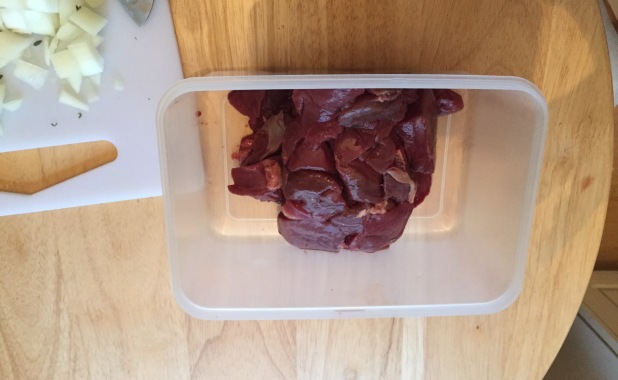
Like I say, I’d never cooked venison before, and when it came out of the plastic packaging it looked revolting – dark red like it was rotten, and liberally sauced in maroon blood that smelled like… a lot of cold, sluggish blood. This picture makes it look much more attractive than it really was.
But never mind. I am committed now. Add your wine, vinegar, and olive oil:
Then add your onions, thyme, seasonings and spices (but not the parsley):
Give that a stir, pop a lid on it and leave it in your fridge for a day, or on your counter for a couple of hours if you’re really pushed.
Making the sauce base
Once time’s unstoppable flow has moved inescapably onwards by one day, take the meat out of the fridge, open the lid and inspect the contents.
This is where everything was very different from the Pies de Parys, which were something that smelled awful while being parboiled but ended up being delicious. In this instance, I took the marinading meat out of the fridge after 24 hours and gingerly popped the lid off.
And guess what?
It smelled AMAZING.
Very hard to describe that moment, but there was this fruity, warmly spiced but rich and savoury thing going on, and I can safely say I’ve never smelled anything like it, but I knew that whatever happened next was going to be A-OK.
So I made the sauce base, which involved tearing up two slices of granary bread and then pouring about 50 to 75mls of rich purple sauce over them (Pleyn Delit recommends using a blender, but to be honest, the bread will break up fine in the cooking process and why bother with the extra washing up?).
Bread is frequently used as a thickener in medieval cookery – see the blaunched porray I made. Here’s me pouring the juices on the sauce base:
Next, mash the bread up with the juices so it becomes this fabulous maroon paste:
Now it’s all on. Time to brown the meat.
Cooking roo broth
So, the next step is to brown the venison with the rest of the olive oil to seal it before you set it on to stew.
Put a big skillet or frying pan on, turn the heat up medium high, and add the olive oil.
Tease your venison chunks out of the marinade mixture with a slotted spoon and put it on kitchen paper to drain (DO NOT THROW THE REST OF THE MARINADE AWAY… don’t look at me like that. Somebody might do it. I remember years ago following a recipe for some chicken I marinaded in soy sauce and I chucked it down the sink before reaching the next line in the recipe book. Not my finest hour.)
Ahem, anyway – here’s the venison draining on kitchen paper:
Gently sear the venison in batches so it takes a plump, taut shape:
Put it in a big stewing pan with the rest of the marinade, the scrapings of your browning pan, the soaked bread paste, and add the water to get everything nice and moist:
Bring this to the boil, then turn down the heat and simmer for one hour, covered. Add more liquid if you think it’s looking a bit dry, but remember you’re after something quite thick, not runny.
Next, add the raisins and parsley, and then carry on cooking for another half an hour.
Taste it for seasoning, then “messe forth” with your frumenty:
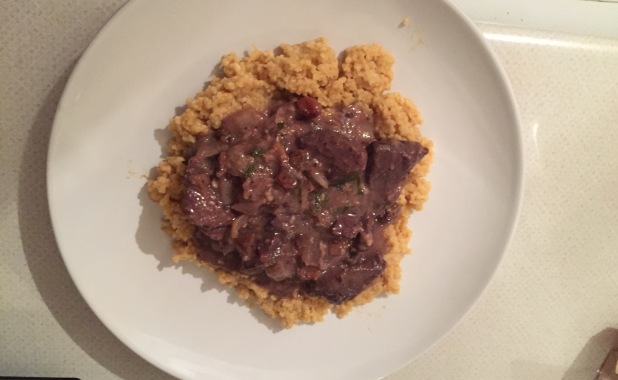
Was it nice?
I’m not sure anything could have been as nice as that smell when I first opened the tupperware box. But it had a go. The venison was something I’d never eaten as whole meat – I’ve eaten venison meatballs and venison grillsteaks (and other things where the venison is frequently admixed with another meat, like beef), but the flesh itself was a revelation – a dark, rich taste, almost like liver in places, and very dense (but tender) in texture. The sauce was piquant and sweet, and married up perfectly with the frumenty I’d made to go with it. It didn’t taste at all vinegary, but had this deep, slightly sour fragrance of red wine, caramelised onion, and warm spice and fruit. Very unusual, but very good.
I now have tupperware servings of roo broth and frumenty made up in the freezer for when I fancy a very quick microwaved dinner that could be cheerfully served to ancient royalty.

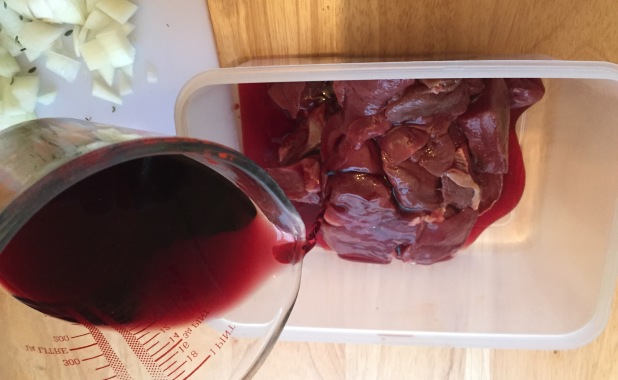
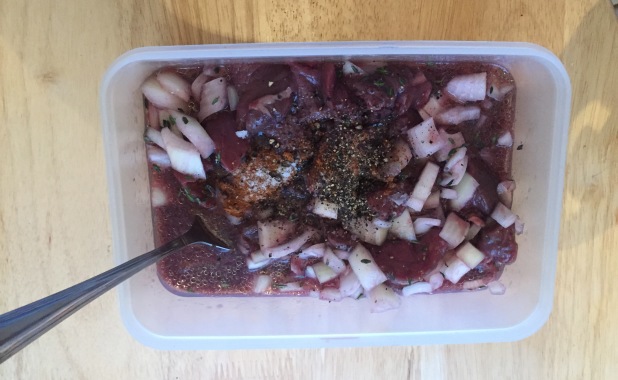
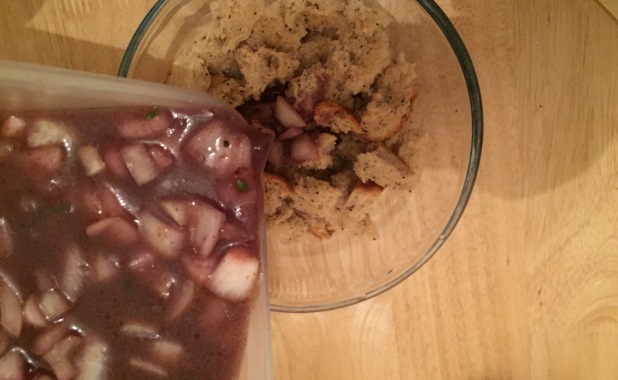
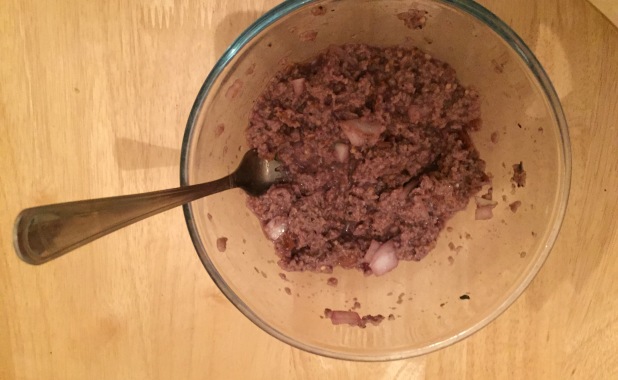
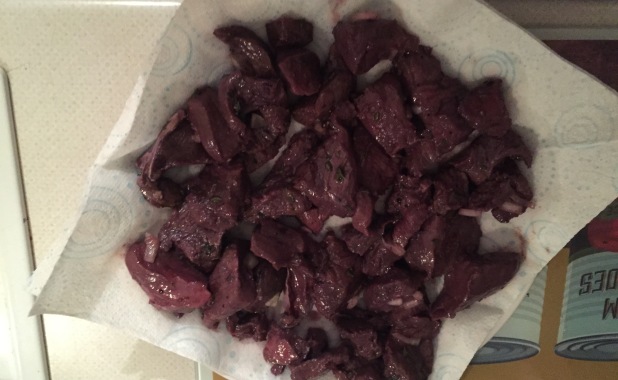
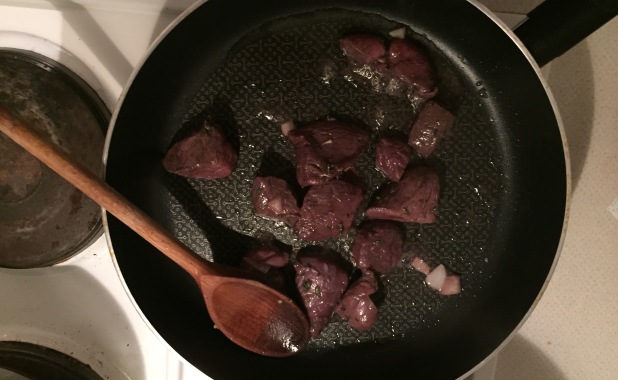
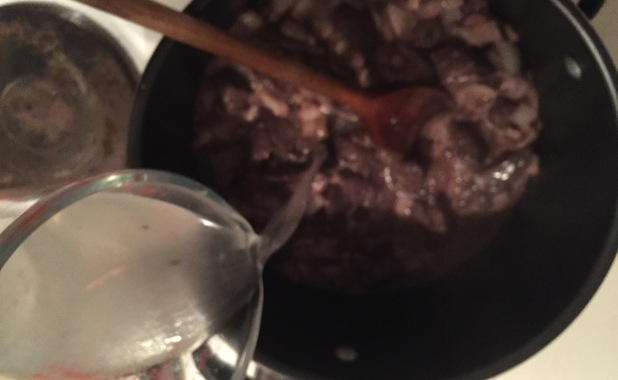
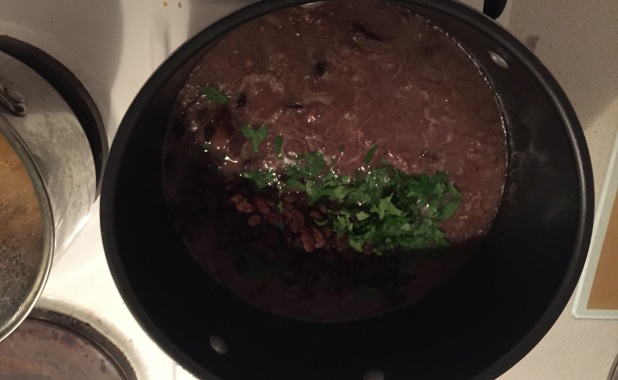

This is one of my favourite stews and yes you are right it smells amazing.
There seems to be a taste for vinegar in a lot of medieval stews and I think it is a sort of Sweet and Sour balanced flavour thing. Look at Egurdouce in the same source which literally translates as Sweet and Sour. I think it works best with goat which may be another meat you haven’t tried.
Nice article by the way.
Thank you for the goat tip – the only time i’ve tried it was in a curry I bought from a van at Glastonbury festival years ago, and I remember next to nothing about it. Experimenting with kid is the next step, I think. So glad you enjoyed the article!